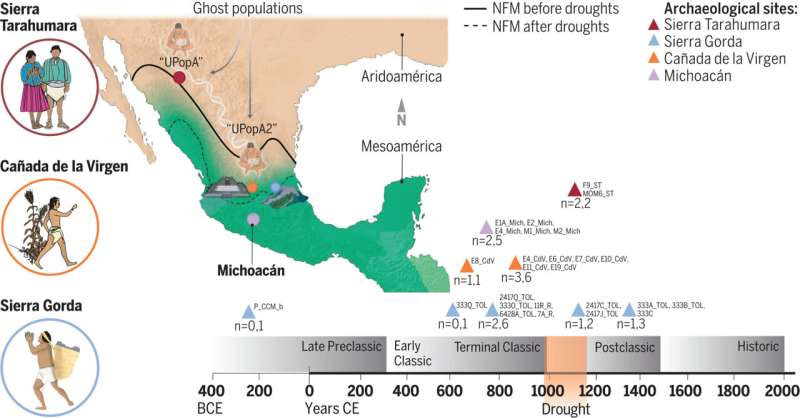May 15, 2023 report
This article has been reviewed according to Science X's editorial process and policies. Editors have highlighted the following attributes while ensuring the content's credibility:
fact-checked
peer-reviewed publication
trusted source
proofread
DNA study shows migration patterns of ancient Mexican civilizations much more complex than expected

An international team of biologists, geneticists, anthropologists and biochemists has found, through genetic analysis, that the migration patterns of ancient Mexican civilizations were much more complex than previously thought. In their study, reported in the journal Science, the group generated genomic and mitochondrial DNA data to test theories surrounding the migration of ancient peoples in Mexico. Bastien Llamas and Xavier Roca-Rada with the University of Adelaide have published a Perspectives piece in the same journal issue outlining the ethical approach used by the research team to learn more about ancient Mexico.
Prior research, based mostly on archaeological evidence, has suggested that drought-driven migration of ancient people from Mexico's north to the south occurred many times in the years before Europeans arrived. The northern region, called Aridoamerica, was dry and mostly desert. The people living there at the time survived as hunter-gatherers. Farther south was Mesoamerica, where early people survived by farming.
Prior research has shown that there were several long-term droughts in Aridoamerica, leading people to move south. But now it appears that these conclusions were in error. Instead of relying on archaeological evidence, the team on this new effort looked at the DNA of people living there to see if they were migrating.
To learn more about the history of the people living in what is now Mexico, the researchers analyzed DNA samples going back approximately 2,300 years. In all, they were able to study 27 samples obtained from eight archaeological sites from people who lived in regions of what is now Mexico.
The researchers could see that the expected migrations had not occurred. They point out, for example, that despite droughts, sometimes decades long, people living in Sierra Gorda did not leave. The team found none of their DNA in people living farther south.
The research team was not able to explain why the northerners had not migrated south when conditions grew dry, but suggest it might have been related to cinnabar commerce. The mineral was easily found in the north, and was sacred to people in the south—thus it seems trade was likely. Regardless of the reasons, the research team suggests migration patterns in early Mexico were far more complex than previously thought.
More information: Viridiana Villa-Islas et al, Demographic history and genetic structure in pre-Hispanic Central Mexico, Science (2023). DOI: 10.1126/science.add6142
Bastien Llamas et al, Paleogenomic study of the Mexican past, Science (2023). DOI: 10.1126/science.adh7902
Journal information: Science
© 2023 Science X Network





















